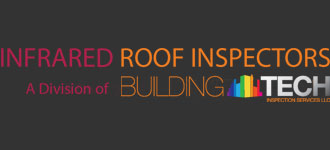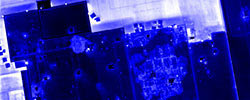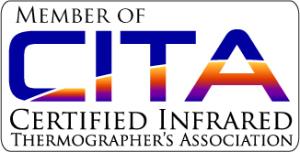For several years flat insulated or uninsulated roofs were walk on by visual examination usually initiated from occupant complaint. Many roofs were replaced based on ones opinion of the roof condition with little to no data. Core cut were used to determine the roof condition but that is based on that one section examined.
In the 1970 commercial consulting firms began experimenting and introducing different instruments such as nuclear moisture density gauges and capacitance meters and airborne infrared thermography by helicopters.
The commercially new introduced testing equipment was not seen as reliable at the time since it was being studied for it reliability and standards for best practices was not developed at that time. At this time USACE started research for the reliability of the testing equipment and various methods for conducting roof moisture surveys in the roofing systems.
The commercially available roof moisture surveys by industry professionals, equipment manufactures and seminars had discussions of different methods. By then the USACE had awarded contracts of several methods for conducting surveys of buildings and started a comparison of all the methods. During these surveys core samples were taken to verify the findings.
Other roof testing equipment and procedures not commercially available but considered worthy for moisture detection was perused.
- Walk On Roof Surveys
- Hand Held Infrared Systems
- Nuclear Moisture meters
- Capacitance Meters
- Microwave Systems
- Impulse radar Systems
- Air Born Surveys All Infrared Thermography
- Fixed Wing
- Helicopters
In time truth will tell
During the 1970s some of the consulting firms suggested that surveys to be conducted without verifying the data during its infancy of the trials. A t this time these types of none destructive testing roof moisture surveys were not reliable, and cross checking the data was needed for the bases of reliability of the method of roof moisture surveys.
WALK ON ROOF SURVEY:
The Microwave and impulse radar systems developed by USACE were both examined. Both systems are able to differentiating wet and dry roof insulation boards, but thus systems were large heavy to maneuver and transport and not commercially available. The survey was conducted in grid patterns, moisture survey is very time consuming and study showed that only a small portion of the roof was actually tested
Capacitance Roof Moisture Surveys:
In this testing equipment the capacitance meters detect changes in the dielectric properties of the roof. The capacitance meters during the trials in the 1970s used in a grid format roof moisture survey were deemed not very reliable. Also the roof types was challenge gravel since the meter pads needed to touch the roof surface, and the damp roof under the gravel made it difficult. The EPDM gave false positives since its conductive membrane, foil face insulation boards. The meters were capable to detecting moisture however it was not able to determine if it’s in the ply’s or insulation boards. In the recent years manufactures such as TRAMEX has improved the equipment with meters to penetrate up six inches depending on the material. Also more efficient systems such as the dec scanner cover more square feet areas in less time.
Nuclear Moisture Surveys:
Nuclear gauge measures moisture concentration within a roof structure utilizing the theory of neutron thermalization. This gauge contains an Americium 241: Beryllium source. This source emits fast neutrons which are then thermalized (or slowed) by hydrogen present in the measurement area. The He3 detector in the gauge then counts the thermalized neutrons. Because other hydrogen bearing materials are present in roof structures, a measurement survey is performed to establish a relative base level, or a gauge reading that indicates a dry area. Areas showing a higher than normal moisture count can then be determined to contain moisture of varying levels. Some of the early 1970s roof moisture survey around most penetration and along the flashing revealed no moisture after core and probes. The nuclear compared to the capacitance meter was a bit more reliable. There were challenges such as flood coats, gravel, and decks affected the readings. The probe and core cuts were still needed to verify the findings and obtaining a base line. A consulting firm WES developed a systematic method for handing the nuclear readings to determine wet and dry thresholds for mapping the roof. It was also required to conduct 4 core of each different type of roofs under this study.
The meters cost around $3000.00 at the time. How this type and capacitance meters are very time consuming and should only be considered if the roof is cover in ballast or uninsulated roofs.
Airborne Infrared Surveys (Aerial Infrared Roof Scans)
Fixed Wing
One consultant had a patent on roof moisture survey from an air craft. The USACE had conducted infrared roof moisture scans during the day time on roof and aerial approach. The day time was not able to provide significant results. The solar effects & shadows and short window of opportunity to survey. The consult firm along with US military air crafts conducted night time infrared roof moisture surveys concluded that anomalies smaller than 3X5 feet were not detected. This is called distance to spot ratio on the infrared camera ability to detect problem form a given distance. The newer equipment is improved significantly depending on the price point and specifications. The preferred method at the time was walk on. The cost of using a helicopter was more expensive than the fixed wing. The aerial infrared roof survey is more economical for conducting several building on one night.
Walk On Infrared Roof Moisture Scans:
The infrared roof moisture scan was most preferred due: distance to roof surfaces able to detect small differences in thermal capacity, marking the roof or highlight the wet areas and examine the physical condition of the roofs.
It was concluded that infrared roof moisture scans walk on or air crafts was the most valuable since it covered every square foot of the roof.
Benefits of Infrared Roof Moisture Scans
Provided its conducted by a qualified Certified Infrared Thermographer trained in a accordance with SNT-TC-1A.
- Evaluated the roofing system before make an uninformed decisions.
- Identifying problem areas to make surgical repairs taking the guessing out of making ineffective repairs.
- The report can be used for roof replacement or repair for bidding.
- Prior to an expiration of a roof warranty to have repairs covered.
- Prior to an extreme weather event to document the roof for insurance claims.
- The infrared moisture scan can be used for replacing or recovering the roof.
- Infrared Roof Inspections for Due Diligence Acquisition prior to purchasing a building.

 Roof maintenance and inspection is a multi-billion dollar industry. Learn the benefits of infrared technology and why you should have your roof inspected.
Roof maintenance and inspection is a multi-billion dollar industry. Learn the benefits of infrared technology and why you should have your roof inspected. Aerial infrared roof inspection offers many great benefits for large commercial and industrial complexes. Learn the details of how this technology can help you.
Aerial infrared roof inspection offers many great benefits for large commercial and industrial complexes. Learn the details of how this technology can help you.






